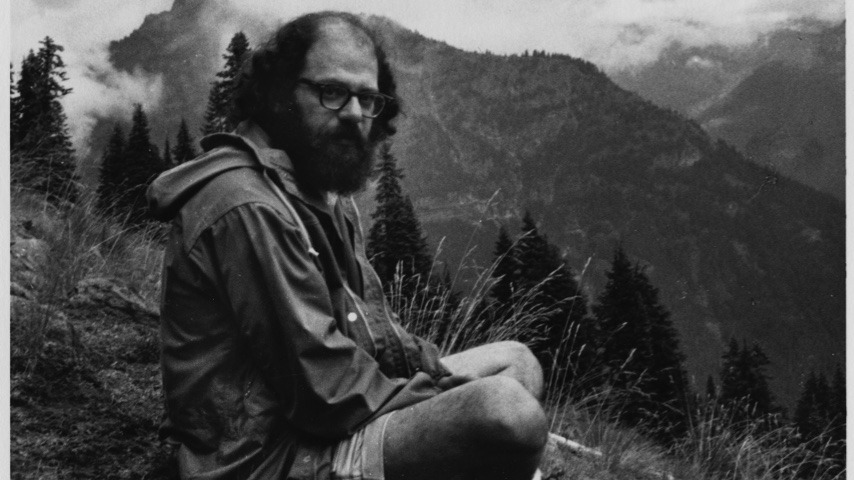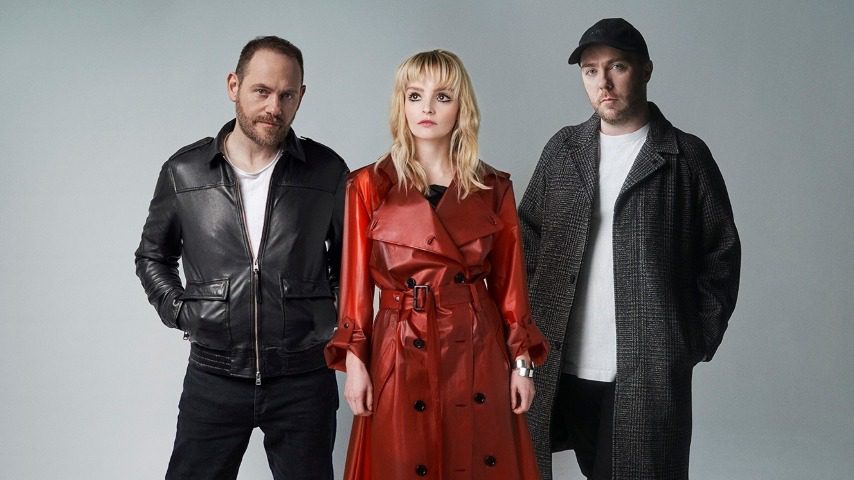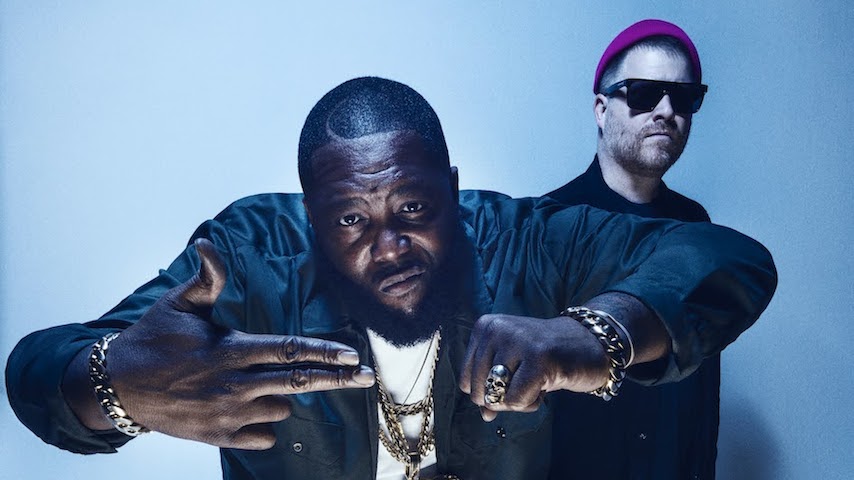The only time I ever saw the Clash in person was August 31, 1982, at Pier 84 in Manhattan. The asphalt wharf jutted out into the Hudson River; nearby were a paddlewheel showboat and a U.S. Navy aircraft carrier bristling with radar and fighter jets. It was a fitting backdrop for a band committed to resisting everything a warship and a nostalgia vessel stood for.
Wandering through the crowd before the show was the legendary beat poet Allen Ginsberg with his balding head, rabbinical beard and Buddhist belly. He had sung a duet with the Clash’s Joe Strummer on the song “Ghetto Defendant” from the British quartet’s latest album, Combat Rock, and now he was here as a kind of guardian angel for the controversial group.
After all, for decades he too had been resisting hostility and convention even as he celebrated sensuality and invention. He debuted his most famous poem, “Howl,” in 1955, the same year that three members of the Clash were born. His career had been a kind of creative crusade, and there he was at Pier 84, giving his blessing to the Clash as a continuation of that same bohemian movement.
Ginsberg was an inspiration for multiple musicians, from Bob Dylan to Patti Smith, but his crucial role in late-20th century Anglo-American music is often overlooked. Two new albums shine a welcome light on those contributions.
The first, The Fall of America—A 50th Anniversary Musical Tribute, is a selection of verse and outtakes from Ginsberg’s 1973 book, The Fall of America: Poems of These States, 1965-1971, set to music by members of the Grateful Dead, the Fugs, Sonic Youth, the Handsome Family, the Virgin Prunes and Yo La Tengo as well as Devendra Banhart, Bill Frisell, Andrew Bird and Angelique Kidjo.
The other album, Allen Ginsberg at Reed College—The First Recorded Reading of Howl and Other Poems, delivers just what its title promises. Ginsberg’s legendary first public reading of “Howl” took place at San Francisco’s Six Gallery in October on October 7, 1955. In the audience were Gary Snyder, Jack Kerouac, Lawrence Ferlinghetti and Neal Cassady, and they immediately recognized the historic nature of the evening. Kerouac described the event in his novel Dharma Bums, and Ferlinghetti published the poem the following year in his City Lights Pocket Poets series—and got William Carlos Williams to write the introduction.
No one taped the reading, however, and it wasn’t until Ginsberg and Snyder went to the latter’s alma mater, Reed College in Portland, Oregon, that the poem was recorded on Valentine’s Day, 1956. Drained by the energy required by the cathartic poem, Ginsberg quit after the famous Part I. But that passage plus seven other early poems capture the poet before he had published a single book, in the first flush of inspiration, on the cusp of a great career. Strummer was not yet four years old, while the Clash’s Mick Jones, Paul Simonon and Topper Headon were not yet one. Terry Chimes, the Clash’s original drummer and back in the band at Pier 84, hadn’t even been born yet.
The year of “Howl”’s debut, 1955, was also the year that Elvis Presley signed with RCA Records and went from being a regional phenomenon to a national force. The year of “Howl”’s publication, 1956, was the year James Brown had his first R&B hit, “Please, Please, Please.” Obviously, something was in the air, a new generation’s dissatisfaction with the conformity, segregation and patriarchy they had inherited.
The poet’s words were as shocking and transforming as the two singers’ music. Just read—or, better yet, listen to—“Howl” with its long, Whitmanesque lines, its nouns and adjectives crammed together by shedding most of the conjunctions and prepositions, its mix of gritty/quotidian realism and religious/hallucinogenic visions, its critique of the present and its imagining of a better future. It begins with one of the most memorable openings in 20th century literature:
I saw the best minds of my generation destroyed by madness, starving hysterical naked,
dragging themselves through the negro streets at dawn looking for an angry fix,
angelheaded hipsters burning for the ancient heavenly connection to the starry dynamo in the machinery of night, who poverty and tatters and hollow-eyed and high sat up smoking in the supernatural darkness of cold-water flats floating across the tops of cities contemplating jazz,…
With nothing to accompany his speaking voice, Ginsberg achieved much of the same impact as the early rock ’n’ rollers: the same thrilling defiance of authority, the same thrilling celebration of bodily pleasures. If the rebellion of Presley and Brown was primarily musical, Ginsberg’s was primarily verbal—and it wouldn’t be till Dylan went electric at the 1965 Newport Folk Festival that those two streams came together. Poetry gained a new power when yoked to song, but so did song. Pop music is a coupling of language and sound, so why shouldn’t the former be as ambitious as the latter?
Even though Ginsberg presented his work on the page and in solo readings, music was always implicit in his work. On the First Recording album, for example, he explains his theory of the “bop refrain, chorus after chorus after chorus, the idea being, say, Lester Young in Kansas City in 1938 blowing 72 choruses of ‘The Man I Love’ till everyone in the hall was out of his head and Young also.”
This reference to the Count Basie Band’s tenor saxophonist (also an acknowledged influence on Kerouac) reveals the crucial role of syncopation and sustained improvisation in the creation of Ginsberg’s poetry. When he starts reading “Howl,” you can hear that jazz quality in the pattern of accents and pauses and in the propulsive momentum of the lengthy lines.
So it makes sense that Ginsberg recognized Dylan as his artistic heir. In D.A. Pennebaker’s 1967 documentary, Don’t Look Back, there’s Ginsberg in the alley behind Dylan, who presents the lyrics to the Ginsbergesque “Subterranean Homesick Blues” on a series of poster boards. In the 2019 film, Rolling Thunder Revue: A Bob Dylan Story by Martin Scorsese, Ginsberg is a supporting character, performing with Dylan for a room of American Indians and communing with Dylan at Kerouac’s grave.
“When you get old is when all your dreams come true,” Ginsberg told me in a 1977 interview “if you have the right dreams. When I was younger, I always wanted to go out on a rock ’n’ roll tour. When I got to be 50, I went out on a rock ’n’ roll tour.” That was a reference to the Rolling Thunder tour the year before.
When Phil Spector was producing Leonard Cohen’s The Death of a Ladies Man in 1977, he cajoled Dylan and Ginsberg into singing harmony on “Don’t Go Home with Your Hard-On.” Patti Smith recorded the Ginsberg song “Spell” on her Grammy-nominated 1997 album, Peace and Noise. At one point, Ginsberg was taking guitar lessons from Dylan. He had already been accompanying himself on the harmonium, a miniature pump organ, during his reading and later traveled with a guitar accompanist.
So it makes sense that a wide range of musicians would want to contribute to The Fall of America—A 50th Anniversary Musical Tribute. The Handsome Family, for example, set Ginsberg’s voice reading the middle section of “Hiway Poesy: L.A.—Albuquerque—Texas—Wichita” to an Americana reverie of pedal steel, theremin and twangy guitar. Thus the details of this road trip across the American West (the Rockies rising as “icy tipped distant earth peaks over hilltops,” a power plant casting “endless iridescence on black velvet desert,” are reinforced by the music. And when the poet begins chanting Hindu sutras, the musical contrast is as vivid as the cultural contrast must have been in the car.
Grateful Dead drummer Mickey Hart composed and recorded a brooding synth track under Ginsberg’s reading of “First Party at Ken Kesey’s with Hell’s Angels.” The ominous music reinforces the poem’s tension between young people dancing to Ray Charles and the Rolling Stones on the hi-fi, and the police cars parked outside the gates of this home in the redwoods. In his liner notes, Hart points to Kesey as the link that brought the beat culture of the ’50s together with the hippie culture of the ’60s, Ginsberg with the Dead. And once again, Ginsberg’s fascination with popular music is explicit.
Many of these poems are travelogues of crisscrossing the nation. Yo La Tengo’s seething synths sneak up under Ginsberg’s eight-minute reading of “Bayonne into NYC,” which evokes north Jersey of 1966 with Springsteenian detail. The Denver-raised jazz guitarist Bill Frisell provides a prickly, sparkling solo-guitar soundtrack for Ginsberg’s reading of “Over Laramie,” the description of a plane flight through a rainstorm over Wyoming and Denver, the weather as wondrous and terrifying as the music.
Andrew Bird takes a different tack; he sings the words himself rather than relying on a Ginsberg sample. “Easter Sunday” is a lovely celebration of a snow-melting spring day on a farm in the woods, and Bird sets the text as a bouncy, whistling, old-time country song. The Virgin Prunes singer Gavin Friday also handles vocals himself on “Death on All Fronts,” a nighttime meditation on our planet poisoning itself, and the music by Scottish trip-hop producer Howie B is as chilling as the language.
Ginsberg himself was a mediocre singer and instrumentalist, not that that stopped him from doing both in public appearances. Eventually he hired accompanists, such as guitarist Steven Taylor, who contributes to The Fall of America. Ginsberg’s best music, though, was in his written language, so full of rhythm and melody, and his attitude, which embraced popular music as a vehicle for poetry.
“The oldest poetry,” he told me, “is chanted. Most poetries have always been connected with chant and music until the invention of the printing press. But that was only temporary—400 years—that’s a small bit of time. You take someone like Iggy Pop or Mick Jagger, and you have poetry and music and dance together. Even Dylan dances a bit. So the ideal combination is the Bardic-shamanistic, poetry-dance music.”




